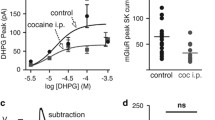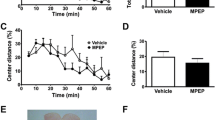Abstract
Rationale: Group-I metabotropic glutamate receptors (mGluRs) are densely expressed in the medium-sized spiny projection neurons of the striatum. Activation of the group-I mGluRs in the rat striatum with a selective group-I agonist, 3,5-dihydroxyphenylglycine (DHPG), produced locomotion and stereotypical behavior. Objectives: This study was designed to evaluate dependence of DHPG-stimulated motor behaviors on the ionotropic glutamate receptors [N-methyl-d-aspartate (NMDA) and kainate/α-amino-3-hydroxy-5-methyl-4-isoxazoleprionic acid (AMPA)]. Methods: In chronically cannulated rats, effects on motor activity of DHPG injected into the dorsal striatum were examined in the presence or absence of the antagonists selective for NMDA or kainate/AMPA receptors. Results: Bilateral injections of DHPG (80 nmol) into the dorsal striatum induced a delayed locomotion followed by a prolonged stereotypical behavior characterized by the repetitive twitching movement of the head and forepaws. Blockade of NMDA receptors with intrastriatal injection of the NMDA receptor antagonist, (±)-3-(2-carboxypiperazin-4-yl)-propyl-1-phosphonic acid (CPP, 2.5 nmol), did not attenuate the behavioral changes induced by DHPG administration. Conversely, CPP unmasked an early onset of locomotion in response to DHPG injection as opposed to the delayed locomotion induced by DHPG in the absence of CPP. Pretreatment of rats with the kainate/AMPA receptor antagonist, 6,7-dinitroquinoxaline-2,3-dione (DNQX, 10 nmol), had no effect on DHPG-stimulated behaviors. CPP administered alone sedated animals, whereas DNQX given alone did not alter spontaneous behavioral activity. Conclusions: Motor stimulation induced by activation of the DHPG-sensitive group-I mGluRs in the striatum is independent upon co-activation of NMDA or kainate/AMPA receptors, since the NMDA or the kainate/AMPA receptor antagonist had no effect on DHPG-stimulated motor activity.
Similar content being viewed by others
Author information
Authors and Affiliations
Additional information
Received: 6 April 1999 / Final version: 28 September 1999
Rights and permissions
About this article
Cite this article
Mao, L., Wang, J. Motor stimulation following bilateral injection of the group-I metabotropic glutamate receptor agonist into the dorsal striatum of rats: evidence against dependence on ionotropic glutamate receptors. Psychopharmacology 148, 367–373 (2000). https://doi.org/10.1007/s002130050065
Issue Date:
DOI: https://doi.org/10.1007/s002130050065




